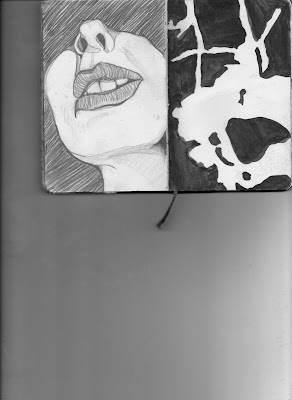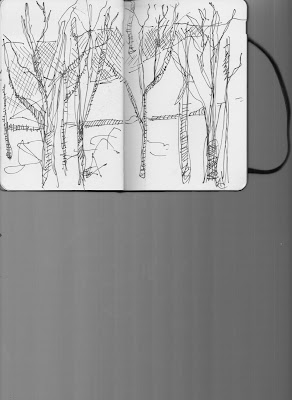Gabriella Copcutt
Saturday, April 9, 2011
Sunday, December 12, 2010
Tuesday, November 30, 2010
Foundation Lecture Series: Book Binding (week 11)
Drawing Final Research
 sooo...for our final project in drawing we need to complete a 6ftx6ft drawing that represents you as a self portrait. Lately I've been really interested in Willem de Kooning and Alex Katz...I did projects on the both of them in high school and since then I've been interested in their work. I like the layering and gestur drawings in de Koonings work...as an abstract expressionist I am fascinated with his work and will continue to do some readingg on his life and influences for artttttttt...
sooo...for our final project in drawing we need to complete a 6ftx6ft drawing that represents you as a self portrait. Lately I've been really interested in Willem de Kooning and Alex Katz...I did projects on the both of them in high school and since then I've been interested in their work. I like the layering and gestur drawings in de Koonings work...as an abstract expressionist I am fascinated with his work and will continue to do some readingg on his life and influences for artttttttt...Although Alex Katz has such a distinct and different style from de Kooning, I love looking at his pieces also. His style is so specific and even though his pieces are so simple his self portrats have interesting expressions and color choices...
I'm not yet sure how these works will influence me but I will keep researching!
Next I'm going to look at some of Gauguin's work!
As far as the drawing goes, I want to use objects to represent the most important and influential people in my life...I'm just not sure who I want the figure/figures to be in the piece...
Tuesday, November 16, 2010
Foundation Lecture Series: Lead Pencil Studio (week 10)
Monday, November 15, 2010
Foundation Drawing Response
"The point is, that every piece of art changes your whole perception of the rest of the world for the rest of your life.
And it's not a joke! And if it doesn't, then it's not art, it's a commodity."
- Lawrence Weiner responding to a question from Liam Gillick in "Between Artists" pg20
When I first read this quote, it immediately put a smile on my face because it is worded so specifically that I could sense the point that Lawrence Weiner was trying to get across and I can find a lot of truth in what he is saying. The point of art is to evoke some type of emotion from the audience, whether the response is a good or bad one and if it doesn't the piece is not considered to be art. The work could be so uninteresting, average, or just awful that you don't want anything to do with it but the fact is that the piece has an effect on you.
Then I began thinking, and I found it interesting that everything you do in a sense everyday and you who are is influenced by your own personal life experiences and I believe that its those life experiences that make up your personality and that is why art speaks so differently to everyone. That is why Weiner can say "that every piece of art changes your whole perception of the rest of the world for the rest of your life," and make the quote so personal and dramatic. A piece of art could evoke a past memory or really convey a deep message to you and stick with you for the rest of your life while another person finds the piece to be average, boring, or even all-around weak.
Also, I think that part of the meaning of a piece of work being classified as art means that it has that type of imapct on it's targeted audience. That is why he says it has such a huge impact on the way you view the world. I think that Weiner realizes that this statement sounds so grandiose and that is why he adds, "And it's not a joke!"
These are the few things about the quote that on the surface I can agree with what Weiner is saying.
Although this may be true, understanding and agreeing with Weiner's quote can depend on how one defines the broad subject of art. When I looked up the definition on "art," two answers caught my eye: 1. "the quality, production, expression, or realm, according to aesthetic principles, of what is beautiful, appealing, or of more than ordinary significance" and 2. "the craft or trade using these principles or methods." Does this mean that art can still be considered "art" and a "commodity" at the same time? It is how one defines art that leads to whether one finds truth to what Weiner states because if art can be both "of more than ordinary significance" (meaning it "changes your whole perception of the rest of the world for the rest of your life" because it stand out to you) and considered a "trade" at the same time, then I disagree with what Weiner is stating.
Another reason I find some fault in what Weiner is saying is because generally, I think that most art is made to arouse a certain response from the viewer; however, what about artists making "art for arts sake"? Can an artist not just make a piece of art for themselves without having to reach out to someone and "change their perception of the world"?
Overall, I think that all artists have one goal in common when creating art: to create something that has not been created before, whether their intention is to evoke an emotion from the audience or just to create their own piece of work- whether that means that the piece of work is considered "art," a "commodity," or both.
And it's not a joke! And if it doesn't, then it's not art, it's a commodity."
- Lawrence Weiner responding to a question from Liam Gillick in "Between Artists" pg20
When I first read this quote, it immediately put a smile on my face because it is worded so specifically that I could sense the point that Lawrence Weiner was trying to get across and I can find a lot of truth in what he is saying. The point of art is to evoke some type of emotion from the audience, whether the response is a good or bad one and if it doesn't the piece is not considered to be art. The work could be so uninteresting, average, or just awful that you don't want anything to do with it but the fact is that the piece has an effect on you.
Then I began thinking, and I found it interesting that everything you do in a sense everyday and you who are is influenced by your own personal life experiences and I believe that its those life experiences that make up your personality and that is why art speaks so differently to everyone. That is why Weiner can say "that every piece of art changes your whole perception of the rest of the world for the rest of your life," and make the quote so personal and dramatic. A piece of art could evoke a past memory or really convey a deep message to you and stick with you for the rest of your life while another person finds the piece to be average, boring, or even all-around weak.
Also, I think that part of the meaning of a piece of work being classified as art means that it has that type of imapct on it's targeted audience. That is why he says it has such a huge impact on the way you view the world. I think that Weiner realizes that this statement sounds so grandiose and that is why he adds, "And it's not a joke!"
These are the few things about the quote that on the surface I can agree with what Weiner is saying.
Although this may be true, understanding and agreeing with Weiner's quote can depend on how one defines the broad subject of art. When I looked up the definition on "art," two answers caught my eye: 1. "the quality, production, expression, or realm, according to aesthetic principles, of what is beautiful, appealing, or of more than ordinary significance" and 2. "the craft or trade using these principles or methods." Does this mean that art can still be considered "art" and a "commodity" at the same time? It is how one defines art that leads to whether one finds truth to what Weiner states because if art can be both "of more than ordinary significance" (meaning it "changes your whole perception of the rest of the world for the rest of your life" because it stand out to you) and considered a "trade" at the same time, then I disagree with what Weiner is stating.
Another reason I find some fault in what Weiner is saying is because generally, I think that most art is made to arouse a certain response from the viewer; however, what about artists making "art for arts sake"? Can an artist not just make a piece of art for themselves without having to reach out to someone and "change their perception of the world"?
Overall, I think that all artists have one goal in common when creating art: to create something that has not been created before, whether their intention is to evoke an emotion from the audience or just to create their own piece of work- whether that means that the piece of work is considered "art," a "commodity," or both.
Tuesday, November 9, 2010
Subscribe to:
Comments (Atom)
































